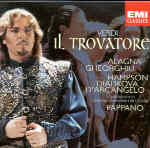…every singer is different–simply because he is alive! tenor Roberto Alagna tells us with great depth and insight in an essay accompanying this release. But more of this revelation later. After a dearth of recorded Trovatores, suddenly they’re falling out of the sky. The recent Muti set was particularly distinguished by its refined playing and the conductor’s ability to let us hear Verdi’s inner voices and lovely orchestration–it was nicely oom-pah free. The singers were good, only what Verdi put on the page was played and sung, and the pacing tingled the senses.
Now Antonio Pappano’s reading arrives, and he’s after something else: blood and thunder, but also characterization. The plot and one-dimensional inhabitants of this opera have been jeered at for so long that this is a conscious attempt to offer portrayals of people we can recognize–and it actually works in most cases. Ferrando alternately emphasizes and whispers the eerie tale at the opera’s start, and he revels in it. We know immediately that he is a good storyteller, but he’s mostly interested in keeping his men’s attention. Ines, Leonora’s lady-in-waiting, is a nervous woman who fears for her mistress; Leonora herself is a dark character, privy not only to flights of great romantic hallucinations but depression. Manrico is a tough cookie who sings romantic songs; di Luna is vicious, obsessed, and lascivious in an almost groin-rubbing way (when he says “T’amo”–“I love you”–it’s grimier than Scarpia). Azucena is the usual nut-case, and even Ruiz, Manrico’s whatever, is a depressive. All of this actually works, seeming less generic than usual.
How’s the singing? Well, it’s pretty remarkable, but there are problems. Ildebrando d’Arcangelo is as good as any Ferrando, rich of voice and involved. Angela Gheorghiu is exquisite. Without erasing memories of Callas in the desperate, sad scenes or Price or Caballé in the purely lyrical ones, she’s magnificent. Her voice is the aural equivalent of halvah–woody yet sweet–and she has absolute control over it. The top gleams and the bottom takes on an expressive hue; she works off the text brilliantly as well.
Roberto Alagna is another issue. He’s definitely alive, as advertised, and he’s very good at both the warrior and poet sides of Manrico, but in a schizoid way. At the end of a particularly noisy “Mal reggendo” he rightly sings the “non ferir” quietly, as marked–but it’s so quiet that it sounds as if someone has put a pillow over his face. Elsewhere the problems are similar: when he’s loud he’s unbearably, aggressively so, and his quiet side is a self-conscious gear-shift to a croon. That having been said, his high-C at the end of “Di quella pira” is thrilling in and out of context, perfect and perfectly sustained for both syllables for 10 seconds, and the brownish tint to his voice remains endlessly appealing.
Larissa Diadkova is, like Urmana for Muti, of the new school of lighter Azucenas (no more Cossotto, Barbieri, Simionato, Stignani–Zajick seems to be the last). Her lowish mezzo is expressive, but I was unmoved by her plight and/or ravings–not a good sign (maybe that’s why Manrico keeps yelling at her). Thomas Hampson as di Luna almost walks away with the show. As usual, especially in Italian opera, his voice is not right for the part–but here he’s fantastic. Not only is the singing beautiful, but as mentioned above, this is some villain(!), one for the books, albeit the non-Verdi-sounding books. The other voices are good, and Pappano, as suggested, wrings the melodrama out of the score without revealing its tritenesses. His orchestra and chorus are excellent.
The recording is almost Karajan-ish in a when-it’s-loud-it’s-too-loud and when-it’s-soft-where’s-the-music way. The soft beginning to Act 2, scene 2 is inaudible at regular volume; ditto the start of the Miserere (is the offstage chorus moaning in a mountain retreat?). I’ll be returning to this set often. It excites, and the Gheorghiu-Hampson chemistry is dynamite.
































